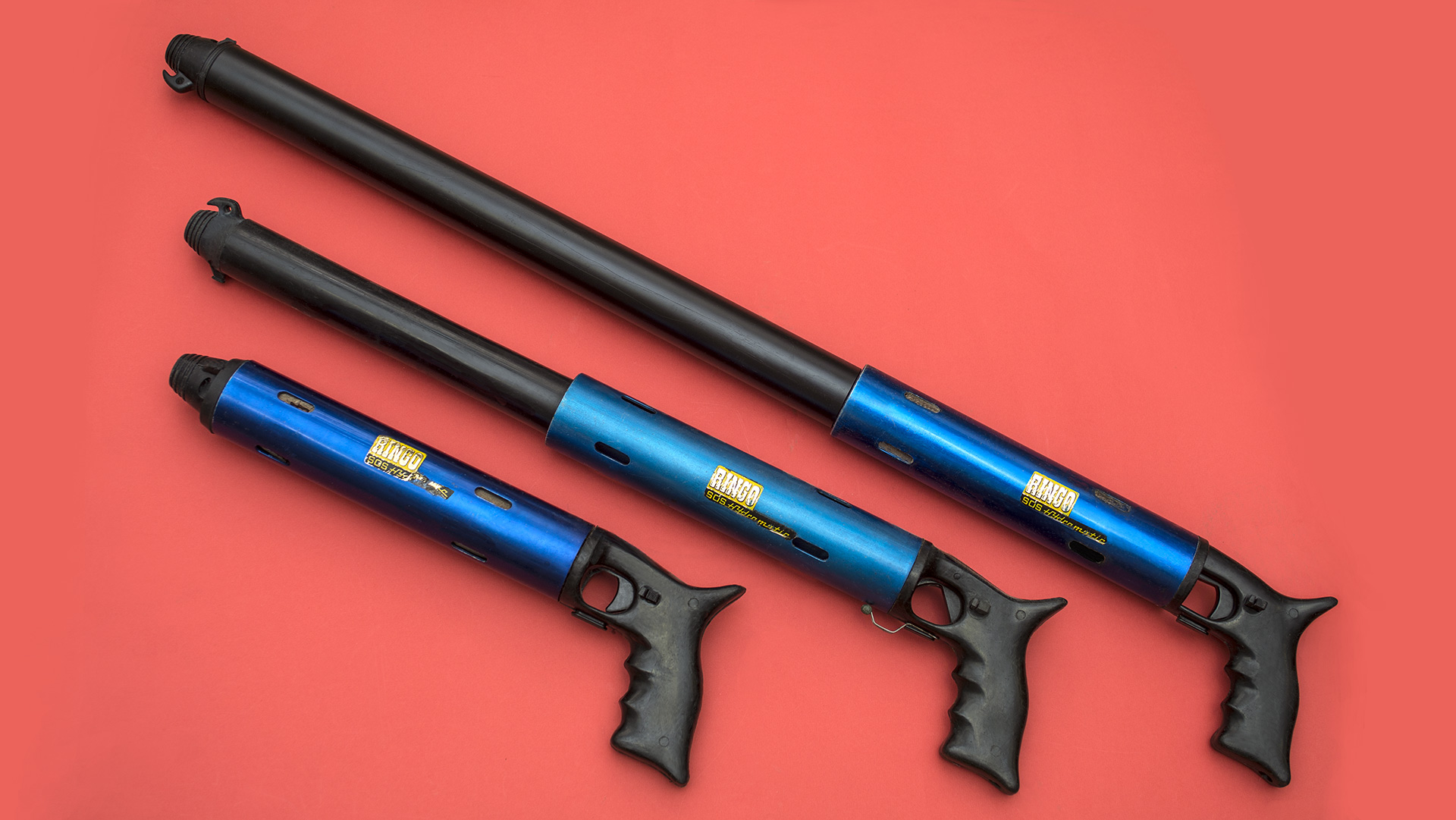The "Ringo" speargun was produced by "SOS" in Italy who also manufactured depth gauges and automatic decompression meters for scuba diving. The SOS decompression meter and the Helium depth gauge were two of their best known products. Scubapro distributed "SOS" products in the USA and through "Airdive" distributed them in Australia, but the main emphasis seems to have been on the scuba-related equipment rather than the "SOS" spearguns. I have never seen a "Ringo" except for a photo of one on eBay and another in the speargun collection of "Willy the Kidd" which used to be viewable on-line, it may still be, but I have since misplaced the URL. One of the "Ringo" guns had a trigger finger guard as part of the rear plastic grip handle and one had no such guard, it may have had a different handle moulding, but otherwise everything else about the two guns looked to be exactly the same.
The "Ringo" had a rear handle, which looked to be moulded in black plastic, that was situated behind the gun rather than under it, so like the current "Airbalete" the inner barrel lined up on the point where your hand gripped the handle rather than being some distance above it. Think of the handle as being something like that on an old style wood saw or panel saw. The tubular body forward of the rear handle was large and anodized in blue, then at about the mid-point the diameter of the body stepped down to a slightly smaller diameter which was anodized in black before terminating in a conical shaped muzzle incorporating the usual fore-sight or line wrap hook. There were also what looked like a few narrow longitudinal slots in the blue body section at either end, but I cannot be sure if they were slots or just some other feature. Beyond this description I know little about the gun except that it was allegedly a hydropneumatic type. Does anyone know anything more about this gun? I doubt that many found their way out of Italy as the "Ringo" appeared at about the time lightweight pneumatic spearguns with rear handles began to dominate the market, so anything that looked a bit odd and did not float after spear discharge was going to be struggling to make sales. I do not know for sure that the "Ringo" was a sinker, but I have never found a hydropneumatic speargun that floats without the spear unless it is enclosed in a bulky buoyancy jacket fitted as an owner modification.
I recall seeing another "SOS" speargun with a rear pistol grip type handle that from memory also had some longitudinal slots in the body tube, it was in the mid-seventies and looked like a grease gun with its all metal construction. It may have been a "hydro-elastic" gun as the salesman said it contained a rubber "vulcabomba", or something to that effect, but his description of the workings of the gun were very vague and he knew little about it except that it was for the surface shooting of flying fish! He said it was very weak when used underwater, but this was not stated as being from his own direct experience. Perhaps the Italian members of this forum may be able to enlighten the rest of us as these "SOS" guns have virtually disappeared without trace.
The "Ringo" had a rear handle, which looked to be moulded in black plastic, that was situated behind the gun rather than under it, so like the current "Airbalete" the inner barrel lined up on the point where your hand gripped the handle rather than being some distance above it. Think of the handle as being something like that on an old style wood saw or panel saw. The tubular body forward of the rear handle was large and anodized in blue, then at about the mid-point the diameter of the body stepped down to a slightly smaller diameter which was anodized in black before terminating in a conical shaped muzzle incorporating the usual fore-sight or line wrap hook. There were also what looked like a few narrow longitudinal slots in the blue body section at either end, but I cannot be sure if they were slots or just some other feature. Beyond this description I know little about the gun except that it was allegedly a hydropneumatic type. Does anyone know anything more about this gun? I doubt that many found their way out of Italy as the "Ringo" appeared at about the time lightweight pneumatic spearguns with rear handles began to dominate the market, so anything that looked a bit odd and did not float after spear discharge was going to be struggling to make sales. I do not know for sure that the "Ringo" was a sinker, but I have never found a hydropneumatic speargun that floats without the spear unless it is enclosed in a bulky buoyancy jacket fitted as an owner modification.
I recall seeing another "SOS" speargun with a rear pistol grip type handle that from memory also had some longitudinal slots in the body tube, it was in the mid-seventies and looked like a grease gun with its all metal construction. It may have been a "hydro-elastic" gun as the salesman said it contained a rubber "vulcabomba", or something to that effect, but his description of the workings of the gun were very vague and he knew little about it except that it was for the surface shooting of flying fish! He said it was very weak when used underwater, but this was not stated as being from his own direct experience. Perhaps the Italian members of this forum may be able to enlighten the rest of us as these "SOS" guns have virtually disappeared without trace.













